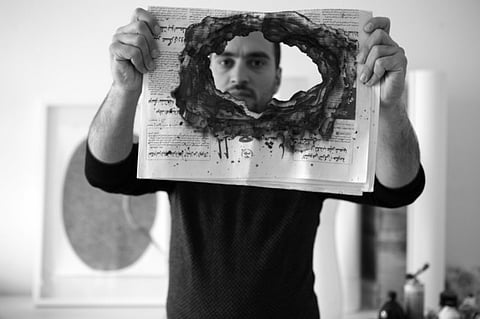Soulful voices from The Resurrection
Artist Jaber Al Azmeh captures the spirit of the Syrian revolution through photographic messages featuring eminent personalities

The situation in Syria forced Jaber Al Azmeh to move from Damascus to Doha. But the artist continues to support the revolution in his country through his art. His latest exhibition in Dubai, “The Resurrection” offers insights into the hearts and minds of the Syrian people and the reasons why despite all odds they continue to protest against the current regime. The show features a series of black and white photographs of people representing a wide cross section of Syrian society, conveying their opinions about the current situation in their country and their hopes for the future. Cameras have played an important role in recording and transmitting what is happening in Syria. But unlike the pictures of violence and destruction seen in the media, Al Azmeh’s photographic artworks depict the spirit of the revolution and its effect on the social landscape of the country.
Al Azmeh began this project in 2011 while he was still living in Damascus. He contacted journalists, poets, artists, actors, doctors and people from all walks of life living in the country and abroad, and photographed them holding a copy of the “Al Baath” newspaper — a potent symbol of the Syrian government and its propaganda. His subjects are seen holding the newspaper upside down, with their personal thoughts and messages about the revolution written in bold, black letters on the front page.
“‘Al Baath’ means The Resurrection. And these pictures are a cynical reference to the true resurrection that we are all waiting for. Through false propaganda the government is trying to create rifts between different sections of society and to project this as a protest limited to specific groups. But my photographs demonstrate that all Syrians, regardless of where they come from, what religion they follow, and what they do, are working together to achieve freedom. This series documents the passionate spirit of the Syrian revolution and our abiding belief in building the Syria of our dreams,” Al Azmeh says.
The messages in the photographs include familiar protest slogans such as “Nothing will stop us”, “Freedom”, and “We are coming for you”; tributes to martyrs and expressions of defiance. A former political prisoner has written “Syria’s freedom is no longer a dream you can throw in jails”. And a photo of the newspaper wrapped around a bottle with a dried rose beside it pays tribute to a civil activist, who was tortured and killed because he registered his protest by offering a rose and a bottle of water to soldiers. Other messages refer to the role of social media in the revolution and to the distortion of facts by the government.
Al Azmeh has carefully composed the photographs to compliment the messages of his subjects. For instance, a famous actress who has dedicated herself to tracking missing protestors is sitting in a row of empty chairs, symbolising the missing people, with the message “We want them, we want them all”. And a dentist, who had to flee from the country due to his active involvement in helping injured protestors, appears with his infant daughter with the message “I want my daughter to have a better life than mine”.
Many people have chosen to convey their message through gestures that speak louder than words such as crumpling the newspaper, covering it with blood stains, burning a hole in it, or poking a finger through it, and posing alongside cages symbolising solitary confinement cells.
Although he completed the project in 2012, this is the first time Al Azmeh is displaying the entire series of 51 portraits. “The concept behind this series was to document different individual stories of the revolution. I wanted to exhibit it after the resurrection of Syria. But I am disheartened by the current scenario and the heavy price Syrians have had to pay for fighting for their rights and dignity. Not only our cities, but also our society has been damaged, and recovery will take a long time. Will these stories be heard above the din of the bombs and destruction?” he asks.
“The Resurrection” will run at Green Art Gallery until June 26.
Box:
Hadil Moufti’s Universe of Imaginary Creatures
As the daughter of a diplomat, Hadil Moufti has lived in many different countries around the world. And the UAE-based Saudi artist’s awareness and understanding of diverse cultures is reflected in her work. Her latest exhibition, “My Universe of Imaginary Creatures” is inspired by her experiences in Africa, and her exposure to the work of European artists such as Klimt. Moufti’s playful paintings feature a menagerie of real and imaginary creatures, including tiny plastic elephants, rhinos, bears, ladybirds and flowers stuck onto the canvasses. The predominance of the colour red in these paintings perhaps alludes to both, the power and the vulnerability of these animals, and focuses attention on our endangered environment.
“Because I have lived in so many different places, I do not feel a sense of belonging to any one particular place. Hence I have always tried to create through my art a world of my own that exists between dreams and reality. My work is not about conveying political or social messages. My aim is to create intrigue and invite viewers to a colourful world, where animals journey through fictional landscapes. It is up to them to form their own interpretation of what this microcosm signifies, and to use their own imagination to let it evolve into a world of their own,” the artist says.
“My Universe of Imaginary Creatures” will run at Showcase gallery, Al Quoz until June 26.
Sign up for the Daily Briefing
Get the latest news and updates straight to your inbox



